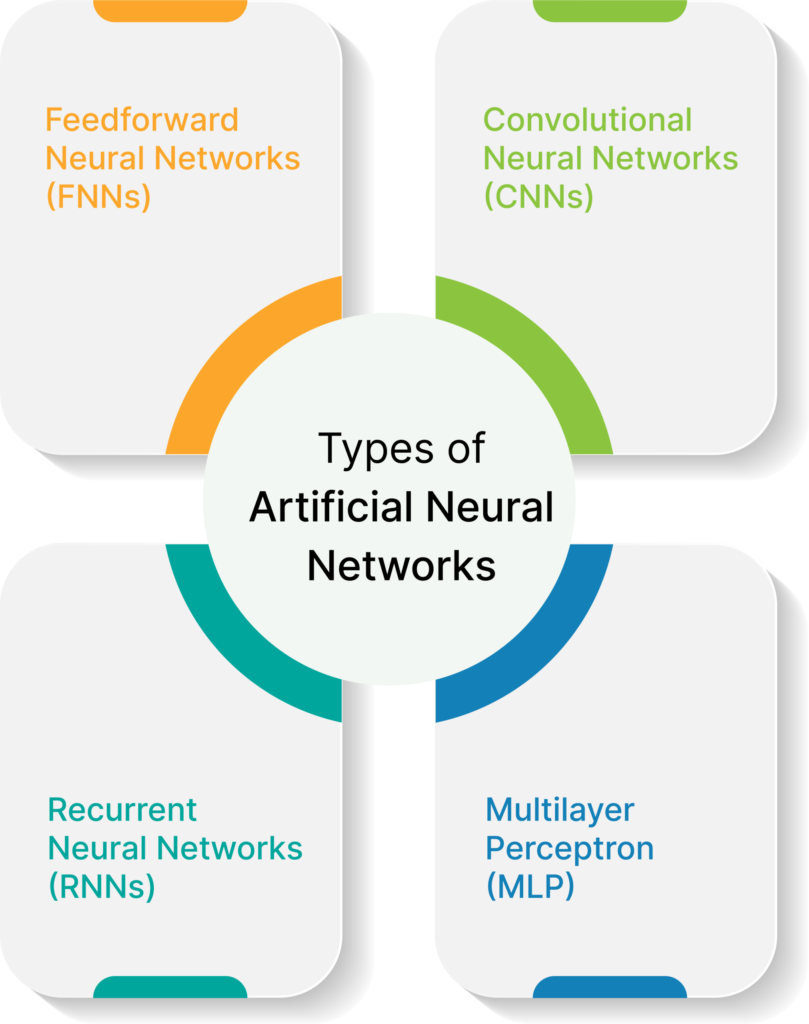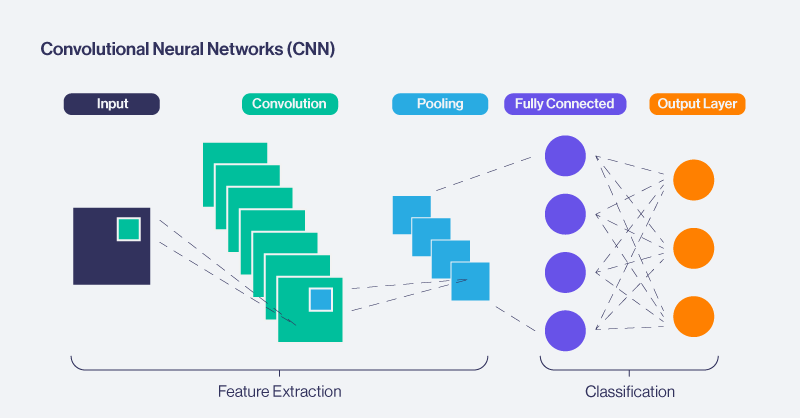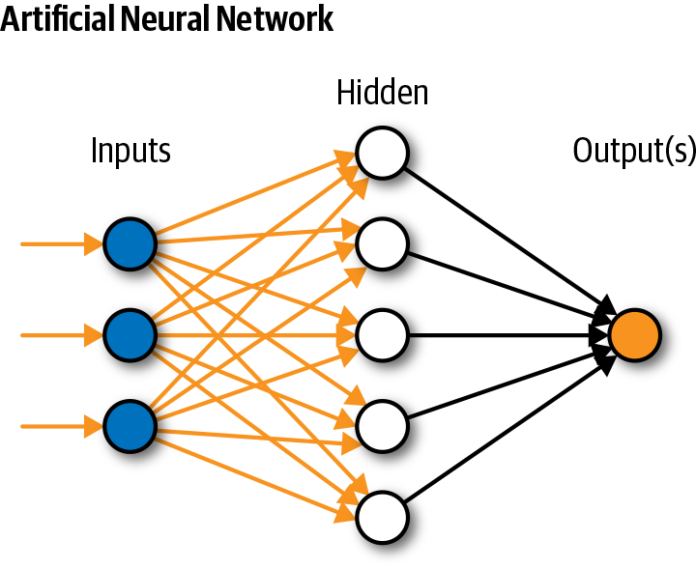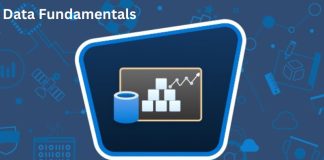Artificial Neural Networks (ANNs) are at the core of modern artificial intelligence and machine learning. Inspired by how the human brain processes information, ANNs enable computers to recognize patterns, make decisions, and learn from experience.
In today’s digital age, ANNs power everything from speech recognition systems like Siri and Alexa, to image recognition in healthcare, and even fraud detection in banking.
This blog explores artificial neural networks in detail, with practical insights, technical depth, and real-world applications.
History and Evolution of Neural Networks
- 1943 – McCulloch and Pitts introduced the first mathematical model of a neuron.
- 1958 – Frank Rosenblatt developed the Perceptron, the first learning machine.
- 1980s – Backpropagation became popular, enabling multi-layer training.
- 2006 – Deep Learning gained traction thanks to Geoffrey Hinton’s work.
- Present – Neural networks dominate AI fields like computer vision, natural language processing, and robotics.
Biological Inspiration: How the Brain Inspired AI
The human brain has billions of neurons that fire electrical signals to transmit information. Similarly, an artificial neural network uses nodes (artificial neurons) connected by weights to pass signals.
- Neuron (Node): Processes inputs and generates an output.
- Synapses (Weights): Strength of connection between neurons.
- Learning: Adjusting weights to minimize errors.
This biological foundation explains why ANNs can adapt and learn like humans.
Key Components of Artificial Neural Networks
An ANN consists of three major layers:
- Input Layer: Receives raw data (e.g., pixels in an image).
- Hidden Layers: Extract patterns and perform transformations.
- Output Layer: Produces predictions (e.g., classifying cat vs dog).
Other key elements:
- Weights & Biases – Parameters adjusted during training.
- Activation Functions – Decide whether a neuron should “fire”.
- Loss Function – Measures error between prediction and reality.
Types of Artificial Neural Networks

- Feedforward Neural Networks (FNNs): Simplest form, no loops.
- Convolutional Neural Networks (CNNs): Best for image/video processing.
- Recurrent Neural Networks (RNNs): Handle sequential data like text.
- Long Short-Term Memory (LSTM): Advanced RNN for long sequences.
- Generative Adversarial Networks (GANs): Create synthetic data like deepfakes.
- Radial Basis Function Networks: Used for classification problems.
Training Process: From Data to Predictions
Training an ANN involves:
- Feeding input data.
- Passing through layers with weights.
- Calculating output.
- Comparing output with actual values.
- Adjusting weights (learning).
This iterative process continues until the model achieves desired accuracy.
Activation Functions and Their Role
- Sigmoid – Maps values between 0 and 1.
- ReLU (Rectified Linear Unit) – Popular due to efficiency in deep networks.
- Tanh – Outputs between -1 and 1.
- Softmax – Converts outputs into probabilities for classification.
Backpropagation and Gradient Descent Explained
- Backpropagation: Error is propagated backward to update weights.
- Gradient Descent: Optimization algorithm to minimize loss function.
Example: In predicting housing prices, backpropagation helps refine weights until predicted and actual prices align closely.
Applications of Artificial Neural Networks
- Healthcare: Cancer detection from medical scans.
- Finance: Fraud detection in credit card transactions.
- E-commerce: Personalized recommendations on Amazon/Netflix.
- Self-driving Cars: Object recognition and decision-making.
- Cybersecurity: Intrusion detection systems.
Real-Time Examples Across Industries
- Tesla’s autopilot uses ANNs to process camera data in real time.
- Google Translate uses RNNs for language translation.
- Spotify employs ANNs for personalized music recommendations.
Artificial Neural Networks vs Traditional Algorithms
| Aspect | Neural Networks | Traditional ML Algorithms |
| Data Handling | Large datasets | Small-medium datasets |
| Complexity | Can model nonlinear relationships | Limited complexity |
| Learning | Feature learning is automatic | Requires feature engineering |
| Applications | Vision, NLP, speech | Regression, small datasets |
Deep Neural Networks (DNNs) and Their Importance
A deep neural network is simply an ANN with multiple hidden layers. Unlike shallow networks that can only learn basic patterns, DNNs can capture complex, hierarchical representations.
- Shallow ANN Example: Classifying whether an email is spam or not using basic word counts.
- DNN Example: Detecting objects within an image (cats, cars, people) where multiple layers detect edges, textures, and higher-level features.
Why Depth Matters
- Lower layers learn simple features (edges, shapes).
- Middle layers combine these into complex features (faces, objects).
- Higher layers make abstract decisions (cat vs dog, fraud vs genuine).
This hierarchical feature learning makes DNNs superior to traditional algorithms.
Hyperparameter Tuning in ANNs
Performance of ANNs heavily depends on choosing the right hyperparameters.
Key hyperparameters include:
- Learning Rate – Controls how much weights are updated in each step. Too high = unstable learning, too low = slow training.
- Batch Size – Number of samples processed before updating weights.
- Number of Hidden Layers and Neurons – More layers = more capacity, but risk of overfitting.
- Dropout Rate – Regularization technique to prevent overfitting by randomly deactivating neurons during training.
Real-time Example: In building a credit fraud detection model, increasing the dropout rate from 0.2 to 0.4 reduced overfitting and improved model generalization.
Regularization Techniques in ANNs
To make models more robust, regularization techniques are applied:
- L1 and L2 Regularization – Add penalties to weights to avoid large values.
- Dropout – Randomly drops neurons to reduce co-dependency.
- Early Stopping – Stops training when validation accuracy stops improving.
- Data Augmentation – Enhances training data (e.g., rotating images for vision models).
Case Example: Google’s image recognition models use heavy data augmentation (rotations, flips, color shifts) to prevent overfitting and improve generalization.
Transfer Learning with Neural Networks
Transfer learning allows reusing pre-trained models on new tasks.
- Instead of training from scratch, use models trained on huge datasets like ImageNet.
- Fine-tune last layers for new tasks with smaller data.
Example:
- A model trained on ImageNet to detect dogs, cats, and objects can be fine-tuned to classify medical X-rays.
- Saves time and resources while improving accuracy.
Popular Pre-trained Models: VGG16, ResNet, Inception, BERT (for NLP).
Advanced Neural Network Architectures
a) Convolutional Neural Networks (CNNs)
Used for image processing. They apply filters to capture spatial features.

- Example: Detecting pneumonia from chest X-rays.
b) Recurrent Neural Networks (RNNs)
Designed for sequential data.
- Example: Predicting stock market trends using past values.
c) LSTMs (Long Short-Term Memory)
An advanced RNN for long sequences.
- Example: Machine translation systems like Google Translate.
d) Transformers
Now dominate NLP tasks.
- Example: GPT models (like the one generating this blog) are based on transformers.
Optimization Techniques for ANNs
Training ANNs can be challenging. Advanced optimizers improve efficiency:
- Stochastic Gradient Descent (SGD) – Standard optimizer.
- Adam (Adaptive Moment Estimation) – Popular for deep learning.
- RMSprop – Great for non-stationary data like time-series.
Example: In natural language processing, Adam optimizer is widely used because it adapts learning rates dynamically, stabilizing training.
Real-World Case Studies
Healthcare: Cancer Detection
- Problem: Identifying tumors in MRI scans.
- Solution: CNNs trained on millions of medical images.
- Impact: Models now achieve accuracy comparable to radiologists.
Finance: Stock Market Predictions
- Problem: Predicting short-term price movements.
- Solution: RNNs and LSTMs trained on historical stock data.
- Impact: Helps traders with real-time decision-making.
Retail: Personalized Recommendations
- Problem: Delivering personalized product suggestions.
- Solution: ANN-based recommendation engines.
- Impact: Amazon reports 35% of sales come from recommendations.
Autonomous Vehicles: Tesla
- Problem: Object detection and navigation.
- Solution: Deep CNNs process camera data in real time.
- Impact: Safer driving with continuous learning from millions of miles.
Artificial Neural Networks in Natural Language Processing (NLP)
ANNs play a major role in language understanding:
- Sentiment Analysis: Classifying text as positive, negative, or neutral.
- Chatbots & Virtual Assistants: Powered by RNNs and transformers.
- Language Translation: Google Translate uses ANN-based seq2seq models.
Real-time Example: OpenAI’s GPT models use transformers, which are advanced neural network architectures for language.
Artificial Neural Networks and Explainable AI
One major criticism of ANNs is that they are black-box models. To overcome this:
- LIME (Local Interpretable Model-Agnostic Explanations) explains predictions locally.
- SHAP (SHapley Additive exPlanations) measures feature contribution.
- Attention Mechanisms highlight important features in predictions.
Example: In healthcare, explainable AI ensures doctors understand why a model predicts “cancer” for a given X-ray.
Integration of ANNs with Emerging Technologies
- AI + IoT (AIoT) – Smart homes using ANNs for device automation.
- AI + Blockchain – Fraud detection in cryptocurrency.
- AI + Quantum Computing – Faster training for deep learning.
- AI at the Edge – Neural networks on mobile devices for offline inference.
Future Directions in Artificial Neural Networks
- Neuromorphic Computing – Chips designed to mimic neurons and synapses.
- Self-Supervised Learning – Learning without labeled data (e.g., GPT pre-training).
- Federated Learning – Training models across devices while keeping data private.
- Hybrid AI Models – Combining symbolic AI with neural networks for reasoning.
Sample Python Code for Neural Network
Here’s a simple regression ANN using Keras:
import tensorflow as tf
from tensorflow import keras
from tensorflow.keras import layers
# Generate sample data
import numpy as np
X = np.random.rand(1000, 10)
y = np.sum(X, axis=1)
# Build ANN model
model = keras.Sequential([
layers.Dense(64, activation='relu', input_shape=(10,)),
layers.Dense(32, activation='relu'),
layers.Dense(1) # Regression output
])
# Compile
model.compile(optimizer='adam', loss='mse', metrics=['mae'])
# Train
model.fit(X, y, epochs=20, batch_size=32, validation_split=0.2)
This model learns to predict a continuous target variable by training on synthetic data.
Comparison with Human Brain
| Feature | Human Brain | Artificial Neural Network |
| Neurons | ~86 billion | Millions (virtual neurons) |
| Speed | Slow (ms scale) | Fast (nanoseconds) |
| Energy | 20W | Hundreds of watts (GPUs) |
| Flexibility | General intelligence | Narrow tasks |
The goal of AI is not to replicate the brain but to mimic certain processes for solving specific problems.
Ethical Concerns in ANN Usage
- Bias in AI – If training data is biased, predictions will be biased.
- Job Displacement – Automation threatens repetitive tasks.
- Privacy Concerns – Training on personal data raises risks.
- AI Misuse – Deepfakes and autonomous weapons.
Solution: AI governance frameworks and explainability.
Challenges and Limitations
- Data Hungry: Requires massive datasets.
- Computationally Expensive: Needs GPUs/TPUs.
- Black Box: Hard to interpret decisions.
- Overfitting: Risk of memorizing instead of learning.
Future of Artificial Neural Networks
- Explainable AI for transparency.
- Neuromorphic computing to mimic brain efficiency.
- Integration with quantum computing for faster learning.
- Smarter edge devices enabling on-device AI.
Tools and Frameworks for Neural Network Development
Popular frameworks include:
- TensorFlow
- Keras
- PyTorch
- Scikit-learn
Each offers libraries, pre-trained models, and tools to build ANNs efficiently.
Conclusion
Artificial neural networks are the backbone of modern AI. From self-driving cars to medical diagnosis, they continue to revolutionize industries. As frameworks improve and hardware evolves, ANNs will become even more powerful, interpretable, and accessible.
FAQ’s
What is the artificial neural network?
An artificial neural network (ANN) is a computational model inspired by the human brain, designed to recognize patterns and solve complex problems by processing data through interconnected layers of nodes (neurons).
What is ANN and its types?
An Artificial Neural Network (ANN) is a machine learning model that mimics the brain’s neurons to process information. Its main types include Feedforward Neural Networks (FNN), Convolutional Neural Networks (CNN), Recurrent Neural Networks (RNN), and Modular Neural Networks (MNN).
What is the purpose of ANN?
The purpose of an ANN is to learn patterns and relationships in data to perform tasks like classification, prediction, image recognition, natural language processing, and decision-making.
What is the basic concept of ANN?
The basic concept of ANN is that it consists of interconnected layers of artificial neurons, where each neuron processes inputs, applies weights and an activation function, and passes the output forward—enabling the network to learn patterns from data.
How many layers are in ANN?
An ANN typically has three main types of layers: the input layer, one or more hidden layers, and the output layer. The number of hidden layers can vary depending on the complexity of the problem.



